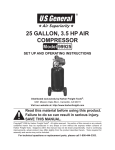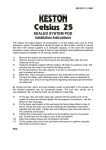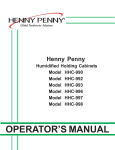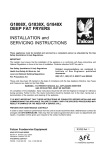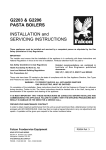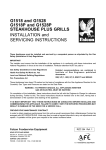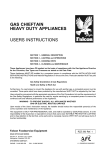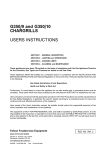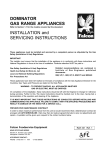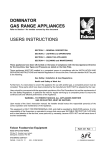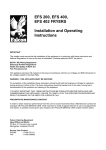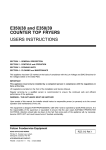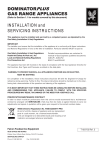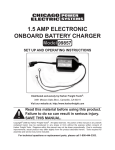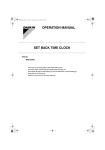Download G350-12!Service Manual
Transcript
G350/11 and G350/12 FREESTANDING FRYERS INSTALLATION and SERVICING INSTRUCTIONS These Appliances must be installed and serviced by a competent person as stipulated by the Gas Safety (Installation & Use) Regulations. IMPORTANT The installer must ensure that the installation of the appliance is in conformity with these instructions and National Regulations in force at the time of installation. Particular attention MUST be paid to - Gas Safety ( Installation & Use ) Regulations Health And Safety At Work etc. Act Local and National Building Regulations Fire Precautions Act Detailed recommendations are contained in Institute of Gas Engineers published documents : IGE/ UP/ 1, IGE/ UP/ 2, BS6173 and BS5440 These Appliances have been CE-marked on the basis of compliance with the Gas Appliance Directive for the Countries, Gas Types and Pressures as stated on the Data Plate. WARNING - TO PREVENT SHOCKS, ALL APPLIANCES WHETHER GAS OR ELECTRIC, MUST BE EARTHED On completion of the installation, these instructions should be left with the Engineer-in-Charge for reference during servicing. Further to this, The Users Instructions should be handed over to the User, having had a demonstration of the operation and cleaning of the appliance. Particular emphasis should be made with regard to safe operation of the drain valve. IT IS MOST IMPORTANT THAT THESE INSTRUCTIONS BE CONSULTED BEFORE INSTALLING AND COMMISSIONING THIS APPLIANCE. FAILURE TO COMPLY WITH THE SPECIFIED PROCEDURES MAY RESULT IN DAMAGE OR THE NEED FOR A SERVICE CALL. PREVENTATIVE MAINTENANCE CONTRACT In order to obtain maximum performance from this unit we would recommend that a Maintenance Contract be arranged with FALCON SERVICE LINE. Visits may then be made at agreed intervals to carry out adjustments and repairs. A quotation will be given upon request to the FALCON SERVICE LINE contact numbers below. Falcon Catering Equipment HEAD OFFICE AND WORKS PO Box 37, Foundry Loan, Larbert. Stirlingshire. Scotland. FK5 4PL SERVICE LINE CONTACT PHONE - 01438 751111 FAX - 01438 369900 RZZ 76 Ref.1 SECTION 1 - INSTALLATION UNLESS OTHERWISE STATED, PARTS WHICH HAVE BEEN PROTECTED BY THE MANUFACTURER ARE NOT TO BE ADJUSTED BY THE INSTALLER Adequate ventilation, whether natural or mechanical, 1.1 MODEL NUMBERS, NETT WEIGHTS must be provided to ensure sufficient fresh air for and DIMENSIONS combustion and for removal of combustion products, DEPTH HEIGHT WEIGHT WEIGHT which may be harmful to health. Recommendations MODEL WIDTH mm mm mm kg lbs for ventilation for Catering Appliances are given in Further, to ensure sufficient room ventiG350/11 350 650 870 46 102 BS.5440:2. lation, guidance on the volume of ventilation air G350/12 700 650 870 84 185 required for different kinds of catering equipment is given in the table. For multiple installations the requirements should be added. Installation should 1.2 SITING be made in accordance with local and/ or national These appliances must be installed on a firm, level regulations applying at the time, and a competent installer must be employed. floor in a well lit position. The fryers can be positioned to within 75mm of a compustible wall, but to allow space for the removal 1.4 GAS SUPPLY of side panels, a clearance of about 150mm should The incoming service must be of sufficient size to be provided at the back. There should be a minimum supply full rate without excessive pressure drop. A vertical clearance of 900mm above the top edge of gas meter is connected to the service pipe by the Gas appliance flue to any overhanging combustible sur- Supplier. Any existing meter should be checked, preferably by the Gas Supplier, to ensure that the face. IMPORTANT If the appliance is to be installed with meter is of adequate capacity to supply the fryer, and other matching appliances of the Falcon 350 series, other associated equipment. This is particularly the Instructions for all units must be consulted to important when a number of units are being installed. determine the necessary clearance to any Installation pipework should be fitted in accordance combustible rear wall or overlying surface. Some with IGE/UP/2. The size of the pipes from the meter appliances require greater clearances than others, to the appliance must be not less than that of the and the largest figure quoted in the individual appliance inlet connection, Rp1/2 (1/2" BSP female). Instructions will therefore determine the clearance An isolating cock must be located close to the appliance to facilitate shut-down during an for the complete suite of adjoining appliances. emergency or routine servicing. The cock must be easily accessible to the user. The installation must be 1.3 VENTILATION The appliance flue discharges vertically through the tested for gas-soundness; details are given in grille at the rear of the hob. There must be no direct IGE/UP/1. The adjustable governor supplied must connection of the flue to any mechanical extraction be fitted to natural gas appliances. system or the outside air. Siting the appliance under a 1.5 ELECTRICAL SUPPLY ventilated canopy is the ideal arrangement. Not applicable to these appliances. EQUIPMENT Range, Unit Type Pastry Oven Fryer Grill Steak Grill Boiling Pan Steamer Sterilizing Sink Bains Marie Tea/ Coffee Machine Ventilation Rate Required m3/ min ft3/min 17 17 26 17 26 17 17 14 11 8.5 - 14 600 600 900 600 900 600 600 500 400 300 - 500 1.6 WATER SUPPLY Not applicable to these appliances. 1.7 HEAT INPUTS NATURAL and PROPANE GAS Model kW Btu/hr G350/11 11.8 40,250 G350/12 23.6 80,500 The G350/12 incorporates two burner systems identical to that within the G350/11. 1.8 INJECTOR SIZES NATURAL and PROPANE GAS Gas Type NATURAL PROPANE MAIN BURNER PILOT BURNER ù2.85mm SIT No.36 ù1.70mm SIT No.19 Warning 1.9 GAS PRESSURE NATURAL and PROPANE GAS NATURAL PROPANE mbar 15 37 inches w.g. 6 14.8 1.10 BURNER ADJUSTMENTS No adjustments are provided, since the burners have fixed injectors and aeration. SECTION 2 - ASSEMBLY and COMMISSIONING 2.1 ASSEMBLY 1. Check parts supplied Check that each pan is equipped with two chip baskets, a pan base panel and a dust cover. (These parts may be packed separately). On NATURAL gas models, an adjustable governor is also supplied. 2. Place the unit in position, and level using the feet adjusters. For safety reasons, both units must be fixed to the floor. Holes are provided in the feet for this purpose. 2.2 CONNECTION TO THE GAS SUPPLY Installation should be carried out in accordance with the various regulations listed on the cover of this manual. On NATURAL gas appliances, the adjustable governor supplied must be fitted in the supply, being securely fixed in a position enabling adjustment to be made during commissioning. On appliances burning PROPANE gas, do not fit a governor. 2.3 CONNECTION TO AN ELECTRICITY SUPPLY Not applicable to these appliances. 2.3 CONNECTION TO A WATER SUPPLY Not applicable to these appliances. 2.5 PRE-COMMISSIONING CHECK After connecting the gas supply, fit a pressure gauge to the pressure test point, and check the installation for gas soundness. To remove protective surface film in the pan, clean the pan thoroughly using hot water and detergent. Rinse out and dry. Ensure the drain valve is closed, and fill the pan with oil to the level inscribed on the back wall of the pan. Purge air from the system, and light the burner, using the following procedure: If the pilot is extinguished either intentionally or unintentionally, wait at least 3 minutes before re-lighting the gas. i) Ensure that the pan contains oil, up to the level mark embossed on the rear wall of the pan. ii) Open the cabinet door, giving access to the controls. iii) Refer to Figure 2, and turn the thermostat knob clockwise to the pilot position . iv) Depress the rectangular button marked and hold it in. v) Depress the spark igniter button, and observe that the pilot lights. If it does not light immediately, repeatedly depress and release the spark igniter button until it does. vi) Hold the ignition button in for a further 20 seconds, then release the button. Observe that the pilot remains lit. If it should go out, wait for three minutes, then repeat from (iv). vii) Having established the pilot, turn the control knob anti-clockwise to the maximum setting and the main burner will light. viii) On NATURAL gas units, if necessary, adjust the governor to produce the required pressure of 15mbar (6 inches w.g.) on the gauge previously fitted. To affect this, remove the governor cap to access the screw, and turn it clockwise to increase the pressure and vice-versa. Replace the governor cap after the correct pressure has been established. Allow the pan to heat up, and check that the thermostat shuts off the gas to the main burner when maximum temperature has been reached. ix) When satisfied that the fryer is functioning properly, shut off the gas by depressing the OFF button (See Figure 1). x) Remove the pressure gauge, and replace the pressure test-point screw. Note The main burner can be shut off, while leaving the pilot lit, by turning the control knob clockwise to the position. Figure 1 - Gas Control Valve 3.3.1 Main Burner After installing and commissioning the appliance, To Remove 2.6 INSTRUCTION TO USER hand the User's Instructions to the user or purchaser and ensure that the person(s) responsible understands the instructions for lighting, cleaning and correct use of the appliance. Particular emphasis should be given to the safe operation of the drain valve. It is important to ensure that the location of the gas isolating cock is made known to the user, and that the procedure for its operation in an emergency be demonstrated. SECTION 3 - SERVICING and CONVERSION Important Before attempting any servicing, turn off the isolating cock, and take steps to ensure that it is not inadvertently turned on. AFTER ANY MAINTENANCE TASK, CHECK THE APPLIANCE TO ENSURE THAT IT PERFORMS CORRECTLY AND CARRY OUT ANY NECESSARY ADJUSTMENTS AS DETAILED IN SECTION 1. After carrying out any servicing or exchange of gas carrying components - ALWAYS CHECK FOR GAS SOUNDNESS! 3.1 CONVERSION PROCEDURE CHECK LIST To convert from NATURAL to PROPANE GAS Change injectors Remove the governor and adjust for new inlet pressure Change data plate To convert from PROPANE to NATURAL GAS Change injectors Install the governor and adjust the inlet pressure accordingly For detailed procedures, refer to the appropriate sections of this document Change data plate i) Remove the burner pipe by unscrewing the compression fittings at each end. ii) From underneath the burner, remove the two M5 nuts securing the pilot bracket to the burner. Ease the pilot burner assembly clear of the burner by moving it slightly downwards. iii) Remove the four screws securing the burner support straps to the body of the fryer, thus allowing the burner to be manipulated clear. iv) Replace in reverse order and check all connexions for gas soundness. 3.3.2 Pilot Burner Assembly To Remove i) Remove the thermocouple, pilot supply pipe from the pilot assembly, taking care not to lose the injector, which will be removed with the union nut. ii) Disconnect the spark ignitor lead at the pilot. iii) Remove the two hexagon nuts securing the pilot bracket to the lower side of the burner, and remove the pilot burner complete with bracket. Replace in reverse order, ensuring that the pilot injector is correctly located in the annular groove in the compression nut. Check all connections for gas soundness. 3.4 INJECTORS 3.4.1 Main Injector To Remove The injector can be removed without the necessity for removing the burner. i) Using a 16mm open ended spanner, reach inside the burner air entry, and engage the spanner on the hexagon body of the injector. ii) Slacken the injector, then reach inside and completely unscrew by hand. If the injector needs cleaning, soak it in a suitable solvent. Do not use metal objects to clear it. 3.5 FLAME FAILURE THERMOCOUPLE To remove the thermocouple from the pilot assembly, undo the split nut and withdraw. To disconnect the overheat limit device from the circuit, pull off the spade connections at the inter3.2 ACCESS TO GAS CIRCUIT COMPONENTS Access can be gained by opening the door on the rupter. front of the appliance. On the G350/12 model (double To disconnect the thermocouple from the valve, undo pan), the circuit components associated with a the hex nut at the valve body. particular pan are mounted on the same side of the 3.6 PIEZO IGNITER/SPARK ELECTRODE support box as the pan itself. 3.3 BURNERS Burners should be cleaned periodically to maintain maximum performance. 3.6.1 Piezo Igniter To remove the piezo unit, pull off the lead at the back, then remove the fixing nut at the rear of the unit. 3.6.2 Spark Electrode This is an integral part of the pilot burner assembly. To Replace i) Remove the thermocouple. ii) Remove the nut securing the lead. iii) Undo the gland nut fixing the electrode to the body of the pilot burner. iv) Remove the electrode by withdrawing downwards. Replace parts in reverse order. Take care not to over tighten the gland nut to avoid the possibility of cracking the ceramic material. The spark gap is pre-determined, and cannot be adjusted. Do not attempt to alter the gap by bending the electrode. 3.7 HIGH TEMPERATURE LIMIT DEVICE This is an electrical thermostat which interrupts the thermocouple circuit. In the event of failure of the control thermostat (embodied in the gas control valve), the high temperature limit device will sense the excessive oil temperature, and open, - thus allowing the gas valve in the control to close. Once triggered, the high temperature limit device must be manually re-set by depressing the red button on the thermostat body. To Remove i) Drain the pan. ii) Remove the front facia panel by removing the two screws in the underside of the panel. iii) Pull off the electrical connections on the interuptor, which are situated at the rear of the gas control valve, and release the electrical leads. iv) Unscrew the four fixing screws and remove the controls chamber base panel. v) Undo the gland nut sealing the capillary tube where it enters the pan. Note THE SAFETY PHIAL IS THE UPPER PHIAL vi) From inside the pan, release the thermostat phial from its mounting bracket by moving it slightly towards the rear of the pan and then upwards. vii) Ease the phial and capillary tube through the pan bulkhead fitting. viii) Remove the two screws fixing the thermostat to its bracket, and remove the complete unit from the fryer. Replace in the reverse order, taking care not to damage the capillary tube. Thereafter ix) Depress the red button to ensure the contacts are closed before lighting the fryer. x) Fill the pan with oil to the level mark. xi) Check that the sealing gland does not leak, but do not overtighten the gland nut. xii) Heat the pan at maximum temperature setting, and allow the control thermostat to cycle once or twice to ensure that the high temperature limit device does not trigger prematurely. The operation of the safety thermostat must be checked at regular intervals. In order to raise the oil temperature sufficiently to enable the safety thermostat to operate, it will be necessary to remove the sensor bulb of the control thermostat from the oil. This condition can be accomplished by the following procedure: i) Drain the pan. ii) Remove the upper panel above the door by removing the screws in the underside of the panel. iii) Unscrew the four fixing screws and remove the controls chamber base panel. iv) Slacken the small gland nut sealing the capillary tube where it enters the pan of the fryer (See Figure 2). Note THE CONTROL PHIAL IS THE LOWER PHIAL v) Remove the phial guard and ease the control thermostat sensor towards the rear of the pan to clear the locating brackets, then draw the capillary tube through the glands to enable the sensor to be suspended out of the oil when the pan is to be refilled to the marked level. vi) Tighten the small gland nut to temporarily compress the seal onto the capillary tube. vii) Temporarily refit the phial guard over the high limit device sensor. viii) Refill the pan with oil to the marked level. ix) Install a means of measuring the oil tempeature. A thermocouple type instrument is preferable, but a mercury thermometer capable of measuring up to 300o C can be used. The measuring sensor, i.e. thermocouple or thermometer bulb, must be suspended 25mm below the surface of the oil, in the centre of the pan. x) Light the fryer, and carefully observe the rising oil temperature. The safety thermostat, if functioning properly, will shut-off the gas when the oil temperature is between 218o C and 224o C (maximum). xi) If the safety thermostat fails to operate at the maximum of 224o C, shut off the fryer immediately by depressing the "off" button on the gas control valve (see Section 2.5 and Figure 1). Allow the oil to cool before investigating the fault. xii) All safety thermostats are accurately calibrated and checked on new appliances during manufacture, and it is unlikely that the calibration will need service adjustment, assuming the thermostat is not otherwise faulty. xiii) Once satisfied that the safety thermostat is functioning correctly, the control thermostat sensor must be re-located in its normal position. A reversal of procedures (i) to (viii) will achieve this condition. Note Replace the seal on the control thermostat gland and ensure that no oil leaks are present. Diagram of Thermostat Stuffing Box and Components Item 1. 2. 3. 4. 5. 6. 7. Description Gland Main Body Washer Washer Lock Nut Split Washers Seal Tubing Nut 3.8 GAS CONTROL VALVE To Remove i) Drain the pan. ii) Remove the gas pipe between the control valve at the burner. iii) Undo the compression fitting at the lower end of the gas inlet pipe on the G350/11 model and at the tee piece on the G350/12 model. iv) Remove the compression nut fixing the pilot supply pipe to the back of the control valve - at the top. v ) Remove the two nuts and bolts securing the valve to its brackets. vi) Remove the four screws and withdraw the top bracket from the valve. vii) Ease the valve forward sufficiently to enable the thermocouple to be removed at the back of the valve, also the electrical connections to the thermocouple interruptor. viii) Unscrew the four fixing screws and remove the controls chamber base panel. ix) Undo the small gland nut sealing the capillary tube where it enters the pan of the fryer (See Figure 2). x) Remove the phial guard and ease the phial through the pan bulkhead fitting. xi) Ease the control clear of the fryer, taking care not to damage the capillary tube. Note - THE CONTROL PHIAL IS THE LOWER PHIAL Re-fit the valve in reverse order, again taking care not to kink or otherwise damage the capillary tube. Check that the pan does not leak at the capillary gland, but do not overtighten this small fitting. Check all connections for gas soundness, using soap and water solution. 3.9 GOVERNOR This applies to NATURAL GAS MODELS ONLY. The type of governor used will normally require little servicing. The air breather hole should be checked for dirt blockage. Always re-check the pressure at the test point after governor maintenance.






